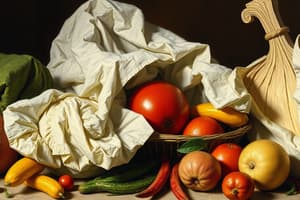Podcast
Questions and Answers
List foods considered potentially hazardous (PHFs).
List foods considered potentially hazardous (PHFs).
Cooked or raw animal products: meat, fish, and poultry; dairy products; cooked fruits or vegetables; raw seed sprouts.
What is the temperature range in the temperature danger zone?
What is the temperature range in the temperature danger zone?
Between 40 °F and 140 °F.
Why should you refrain from keeping food in the temperature danger zone?
Why should you refrain from keeping food in the temperature danger zone?
Food poisoning bacteria multiply between 5°C and 60°C.
What is the maximum amount of time PHFs should be in the temperature danger zone?
What is the maximum amount of time PHFs should be in the temperature danger zone?
Which ingredients alter the pH of foods and slow down bacterial growth?
Which ingredients alter the pH of foods and slow down bacterial growth?
Why do dehydrated foods have a long shelf-life?
Why do dehydrated foods have a long shelf-life?
Describe why foods stored in MAP packaging last longer.
Describe why foods stored in MAP packaging last longer.
How do you kill bacteria in food?
How do you kill bacteria in food?
How do you kill a virus in food?
How do you kill a virus in food?
Which food is associated with Trichinella spiralis?
Which food is associated with Trichinella spiralis?
List examples of chemical hazards.
List examples of chemical hazards.
List examples of physical hazards.
List examples of physical hazards.
List examples of biological hazards.
List examples of biological hazards.
List common food allergens.
List common food allergens.
Describe safe methods of thawing food.
Describe safe methods of thawing food.
The internal temperature you should reach when cooking steak rare is __________.
The internal temperature you should reach when cooking steak rare is __________.
Describe hot-held foods and how they are kept hot.
Describe hot-held foods and how they are kept hot.
Flashcards are hidden until you start studying
Study Notes
Potentially Hazardous Foods (PHFs)
- Includes cooked or raw animal products: meat, fish, poultry.
- Dairy products, cooked fruits or vegetables, and raw seed sprouts are also considered PHFs.
Temperature Danger Zone
- Defined as the temperature range between 40 °F and 140 °F.
- Bacteria rapidly multiply in this zone, potentially doubling in 20 minutes.
- Food should not be left in this temperature range for more than 2 hours to avoid food poisoning.
Risks of the Temperature Danger Zone
- Food poisoning bacteria thrive between 5°C and 60°C (41°F and 140°F).
- Keeping foods outside this range reduces the risk of illnesses.
Time Limits for PHF Storage
- PHFs should not exceed 2 hours within the temperature danger zone.
pH Alteration and Bacteria Growth
- Cooking food to at least 165°F effectively kills harmful bacteria.
- Proper cooling and refrigeration of leftovers within 2 hours help limit bacterial growth.
Shelf Life of Dehydrated Foods
- Dehydrated foods have extended shelf lives due to moisture removal, creating stability.
Modified Atmosphere Packaging (MAP)
- MAP extends the shelf life of fresh food by replacing air inside packaging with a gas mix that preserves freshness.
Killing Bacteria in Food
- Cook foods to a minimum of 165°F to ensure bacteria are killed effectively.
Killing Viruses in Food
- Cooking food to 70°C (158°F) in all parts effectively kills sensitive viruses.
- No infections have been reported from properly cooked poultry products containing H5N1.
Trichinella Spiralis
- A parasitic infection from consuming undercooked or raw pork, causing trichinosis.
Examples of Chemical Hazards
- Include acids, cleaning products, heavy metals (e.g., mercury, lead), paint, and pesticides.
Examples of Physical Hazards
- Include electricity, radiation, pressure, noise, heights, and vibrations.
Examples of Biological Hazards
- Pathogens such as mold, sewage, airborne illnesses, and animal droppings.
Common Food Allergens
- Eggs, tree nuts, peanuts, shellfish, wheat, soy, and fish.
Safe Methods of Thawing Food
- Thaw in the refrigerator, cold water, microwave, or cook from frozen without thawing.
Internal Cooking Temperatures
- Steak varieties:
- Rare: 130-140°F
- Medium Rare: 145°F
- Medium: 160°F
- Well Done: 170°F
- Ground beef: 160°F
- Leftovers and chicken: 165°F
Hot-Held Foods
- Must be maintained at 135°F or above to prevent bacterial growth.
- Preheat equipment like steam tables and holding cabinets to ensure safety.
Cooling Foods Before Refrigeration
- Safe cooling methods should be applied to minimize bacterial growth before food is stored.
Studying That Suits You
Use AI to generate personalized quizzes and flashcards to suit your learning preferences.




